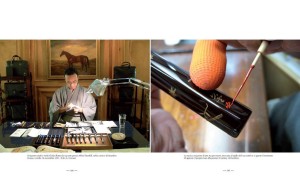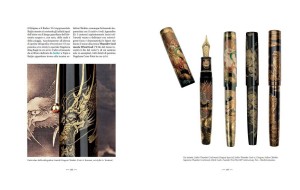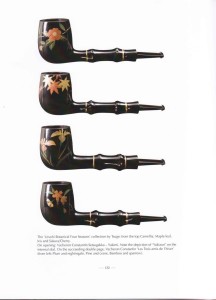Alberto Gerosa tells the story of Maki-e
Renown Namiki artisan Seiki Chida photographed in his workspace.
The Japanese art of maki-e is at once surface and symbol – beyond technical mastery, maki-e is also rich in symbolism and cultural heritage. In “Maki-e: A Story Waiting to be Written”, Alberto Gerosa takes us on a picturesque journey through the world of exquisite lacquered fountain pens, and into the heart of this traditional art form.
Maki-e typically employs the use of metallic powders sprinkled onto Japanese lacquer, or “urushi”. It is widely regarded as having originated in the Heian period from (794 – 1185) and spread during the Tokugawa Shogunate (1603 – 1868). For centuries, it was an art exclusively for the wealthy feudal lords or “daimyo”.
After the fall of the Tokugawa Shogunate to Emperor Meiji, traditionally made handicraft was exported to Europe – in 1925, the first Maki-e pen made by Namiki was sold to Dunhill in London. Today, Dunhill-Namiki fountain pens are highly sought after by collectors worldwide and fetch bids in the hundreds of thousands (Lyn, 2003).
Having mentioned that, the author does not discriminate pens based on their price points. Whether is the more elaborate auction pieces or more affordable models, the book has them all covered – the Namiki Nippon Art Origami Series which employs Hira-maki-e techniques is also featured.
Whereas literature on the subject of maki-e typically expounds upon the various techniques themselves, Maki-e: A Story Waiting to be Written takes a different approach. The 200-page publication presents maki-e motifs as a narrative, focusing on the various themes representative of the art form over the past decade – from the beauty of nature, to aristocracy and the subject of dreams and nightmares.
In “Not Just Fountain Pens”, Gerosa explores maki-e decorated pipes and luxury watches.
The book consists of eight chapters – Earth, Sea and Sky, The Cycle of Seasons, The Shining Prince, The Kabuki and Noh Theatres, The Edo Period, Of Demons, Dragons and Heroes, Not just Fountain Pens, Dwellings for a Dream. Three appendices are dedicated to – Maki-e and its Followers, Alchemy at the Court of Writing and Nibs: A Prestigious Supporting Cast.
Amidst a sea of dazzling art pieces that most would not imagine putting into daily rotation, Gerosa recognises that sometimes simplicity is the ultimate sophistication – the Namiki Yukari Royale Urushi, for example, is said to “allude to a crimson dawn, but also to dusk”. The minimalist fountain pens are treated with “Roiro-nuri” lacquer finishing, which gives them an unmistakable deep red and black sheen.
Maki-e: A Story Waiting to be Written also explores literary and artistic works of cultural significance in Japan, such as the “Tale of Genji” inspired fountain pens from Namiki, Sailor and Pelikan. Gerosa’s deep understanding of the Murasaki Shikibu classic allows him to pinpoint the significant stylistic elements adorning each pen, and which chapter of the book they allude to. Also featured are “Kabuki” and “Noh” theatre inspired designs from Danitrio, Sailor and Pelikan and Dunhill-Namiki.
Recognising the broad application of maki-e in objects other than fountain pens, Gerosa has even dedicated a chapter to it. “Not just Fountain Pens” explores other luxury products embellished with maki-e – from Tsuge tobacco pipes to watches from Vacheron Constantin and Chopard. In “Dwellings for a Dream”, he pays tribute to elaborately decorated pen boxes, while “Nibs: A Prestigious Supporting Cast” explores nib manufacture and specialty nibs by Sailor.
Featuring passionate commentary by Alberto Gerosa and breathtaking imagery by photographer Andrea Bressan and stylist Anna Trentani, Maki-e: A Story Waiting to be Written is the essential compendium for collectors and admirers of maki-e alike.
About the Author: Alberto Gerosa was born in Milan in 1974. He graduated in Philosophy from the Università Ca’ Foscari, Venice, writing a thesis on Nietzsche and Strindberg. Since then, he has been a professional journalist working with the Penna and Penna Vintage magazines, as well as other periodicals in the luxury and watchmaking sector. Gerosa was editor-in-chief of an art magazine and today lectures at the University of Vienna.
“Maki-e: A Story Waiting to be Written”, was generously made available for review by the author, Alberto Gerosa of Italy. Released in Italian and English, it is available from the Penna Magazine shop in both hard-copy and eBook versions and retails for €137 and €35 respectively.
References:
Gerosa, A. (2012). Maki-e: A Story Waiting to be Written – A Journey through the World of Lacquered Fountain Pens. Milan: OPS S.r.l. (ISBN:978-88-901012-9-8)
Lyn, B. (2003). Maki-e, an art for the soul. (ISBN: 957-9403-07-4)




